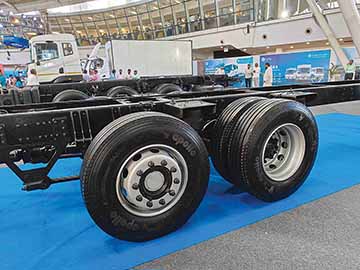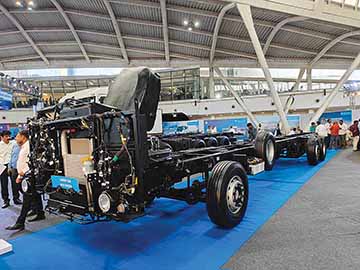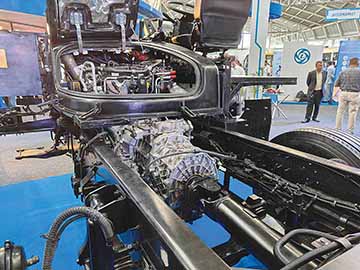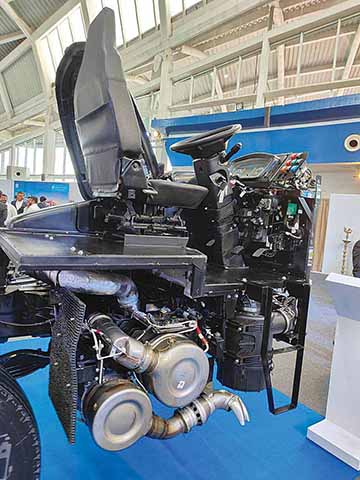Ashok Leyland has unveiled the Garud, a testament to advancements in bus chassis engineering featuring an innovative architecture and quality aggregates, writes Upendra Kasbekar.
At Prawaas 4.0, a premier event organised by the Bus & Car Operators Confederation of India (BOCI), Ashok Leyland unveiled the Garud 15m, front engine multi-axle chassis, a first. Marking a pioneering step in Indian bus powertrain development, the Garud is designed explicitly for intercity travel. This chassis isn’t just a platform for long-distance vehicles it’s a high-precision engineered base that integrates advanced components designed to withstand India’s diverse road conditions, offering unparalleled structural support, stability, and endurance as per Shenu Agarwal, MD and CEO, Ashok Leyland.
The Garud chassis is testimony to advancements in bus engineering, with specialised components like its advanced axle architecture, a robust frame structure, and robust aggregates like tyres. This has resulted in a versatile, high-performing foundation for intercity bus bodies. While designed to support a 15m coach, multi-axle configuration, the Garud’s chassis structure is claimed to offer an unmatched reliability for operators, with an emphasis on easy maintenance and operational efficiency.
Frame and structural design
Ashok Leyland’s engineers have designed the frame to withstand heavy loads while providing flexibility for body customisation. With a maximum Gross Vehicle Weight (GVW) of 22.5-tonne (22,500 kg), the chassis is built to support high-capacity passenger configurations. This structural integrity is achieved through the use of reinforced steel beams and strategically placed cross-members, which provide stability without adding excessive weight to the chassis.
The frame design allows for efficient load distribution, which is crucial when accommodating the large sleeper and seating capacities of the Garud. The incorporation of high-strength materials and structural elements not only boosts durability but also simplifies maintenance, as the frame is designed to facilitate easy access to key components. This structural strength is designed to ensure longevity and lower maintenance cost. The chassis’s engineering also facilitates the inclusion of spacious luggage compartments, catering to the needs of long-haul travellers.
At the heart of the Garud lies Ashok Leyland’s reliable A-Series engine, producing 250 hp and 900 Nm of torque. This powertrain, designed for heavy-duty commercial applications, is tuned to handle the high demands of extended routes, providing a balance between robust performance and fuel efficiency. The engine’s compatibility with Selective Catalytic Reduction (SCR) technology for emission control aligns with BS-VI standards, featuring an AdBlue tank to support cleaner exhaust emissions. It is mated to a six-speed manual synchromesh transmission, optimised for power delivery, enabling smooth shifts, supported by a cable shift mechanism for precise control. An air-assisted hydraulic clutch further enhances drivability, allowing drivers to navigate different terrains with ease. It is claimed to significantly reduce driver fatigue. With a standard 375-litre fibre-based fuel tank resistant to rust and impact damage, the Garud is also equipped with an optional dual-tank configuration for range extension. Agarwal drew attention to Ashok Leyland consistently leading the way in developing cost-effective technologies that benefit both customers and commuters. “We are excited to unveil India’s first front-engine multi-axle bus chassis, designed to accommodate 42 sleeper berths. The GARUD 15m represents a significant leap forward in bus chassis technology, combining advanced engineering with unparalleled comfort and efficiency,” he emphasised.
Suspension and axle configuration
The axle configuration on the Garud 15m is designed to enhance stability and load distribution, critical factors for multi-axle intercity buses. At the front, the parabolic leaf-type suspension provides robust support, contributing to balanced weight distribution and effective shock absorption. This suspension system is paired with a heavy-duty front axle that enables the vehicle to handle sharp turns and undulating roads.
The rear setup features an innovative pneumatic suspension system with an anti-roll bar for stability, especially critical for larger vehicles that carry significant passenger loads. The main rear axle functions as the drive axle, while a secondary “tag axle” provides additional support. This dual-axle design not only maximises load-bearing capacity but also enhances the overall stability and handling of the chassis, particularly important for high-occupancy vehicles, explained Ashish, DSM, Navi Mumbai. Furthermore, the rear-driven axle includes a balancer on the differential, designed to evenly distribute load and reduce impact forces on suspension components. This configuration minimises wear and tear on key parts, extending the life span of the chassis and reducing maintenance costs for operators.
 High-Performance tyres and load resilience
High-Performance tyres and load resilience
Ashok Leyland has carefully selected the tyres for the Garud, given the importance of this component in a vehicle of such scale and capacity. The chassis is equipped with high-performance Apollo 295/80 R22.5 tubeless and radial tyres with a wheelbase of 7650 mm. designed for durability and load resilience. The tyre’s design includes reinforced sidewalls and treads engineered to maximise traction and reduce the risk of punctures on rugged roads, a common challenge in long-distance travel. By reducing rolling resistance and optimising tyre pressure distribution, the advances have helped the OEM attain higher fuel efficiency which in turn translates to lower TCO.
Enhanced braking and safety systems
The chassis incorporates disc brakes on the front axle, an advanced choice that significantly improves stopping power, ensuring effective braking even under heavy loads. Paired with heavy-duty brake callipers, the disc brake system delivers robust, dependable performance.
On offer, a retrofit braking system integrated into the propeller shaft, which activates during deceleration to slow down the shaft’s rotation. This system effectively reduces wear on the brake shoes, extending the life span of the braking components. By providing smoother deceleration, the retrofit braking feature minimises the jolts commonly felt in sudden stops, a significant enhancement in passenger safety and comfort.
Additionally, there is an electromagnetic retarder that acts as an auxiliary braking system, assisting with controlled descent on slopes or when travelling at high speeds. This retarder system supports the main brakes and further reduces wear on brake components while enhancing driver control and ensuring smoother stops.
Battery and electrical components placement
The battery is located on the left side of the chassis, equipped with a cut-off switch for easy access during maintenance. This strategic placement enables flexible body-building options, allowing operators and builders to configure the vehicle layout according to specific requirements while maintaining accessibility for repairs and inspections.
Additionally, the chassis includes dedicated electrical harnesses and routing channels to protect wiring from the impact of vibrations and road shocks. This attention to detail in the electrical layout minimises the risk of shorts or component damage.
Understanding the importance of driver comfort and control, Ashok Leyland has equipped the Garud with several driver-focused features. An ergonomically designed steering wheel and an intuitive instrument cluster further improve the driver experience. The dashboard layout includes dedicated switches for essential functions such as air conditioning, hill descent control, and regeneration, all within easy reach. This driver-centric design enables drivers to maintain focus on the road and respond to route conditions effectively, contributing to safer journeys for passengers and cargo. ACI













Leave a Reply